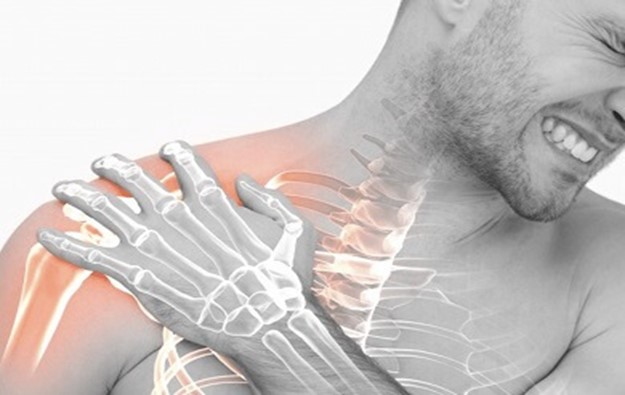Parsonage-Turner syndrome (PTS) is a rare autoimmune disorder that causes inflammation in the brachial plexus, leading to severe shoulder pain followed by muscle weakness and atrophy. This can be misdiagnosed as other conditions, such as brachial plexus injury, cervical radiculopathy, or brachial plexus compression by a mass lesion. PTS is usually diagnosed after other possible causes have been ruled out, and electromyography (EMG) can support the diagnosis by showing denervation in an atypical pattern. While viral infections are the most common cause of PTS, it can also be triggered by surgery, vaccination, and childbirth. This article presents a unique case of PTS, highlighting the implications for medical professionals.
Case 1
A 79-year-old woman without notable medical history underwent a biopsy on a mass over her right levator scapulae. Post-procedure, she developed sharp pain and muscle weakness in her neck and scapula, worsening over time. She reported pain in her right cervical region, radiating down her arm with paresthesia, alleviated by supporting her right upper extremity. Physical examination revealed right shoulder droop, mild decrease in shoulder external rotation, and resisted abduction. The seated shoulder shrug was weak on the right, and atrophy of the right deltoid was noted. The serratus anterior strength test showed an increased tendency to wing on the right. Ultrasound revealed atrophy in the right levator scapulae with mild arthritic changes in the acromioclavicular joint.
Initially thought to be a brachial plexus injury from the recent procedure, further investigation revealed a complex pattern consistent with PTS. EMG findings included suprascapular median nerve neuropathy, mild carpal tunnel syndrome, and type 3 ulnar neuropathy with entrapment at the right elbow. Four months later, the carpal tunnel syndrome persisted, but suprascapular median nerve neuropathy and ulnar neuropathy resolved. External rotation limitation and shoulder atrophy persisted, yet there was an improvement in proximal shoulder and distal trapezius function.
Eight months post-biopsy, the final EMG showed normal median and ulnar responses, with complex repetitive discharges in the levator scapulae, indicating muscle re-innervation. Ten months after the biopsy, near-complete restoration of shoulder droop was observed, with progressive muscle mass improvement. Active shoulder abduction measured 150° on the right and 160° on the left, while right shoulder external rotation continued to exhibit weakness compared to the left.

Figure 1: Sagittal MR Cervical Spine

Figure 2: Sagittal MR Shoulder

Figure 3: Coronal MR Shoulder
Discussion 3,4
PTS often faces misdiagnosis amid concurrent procedures and diagnoses. A reported case highlights PTS diagnosis post rotator cuff surgery. Despite potential PTS origins, the diagnosis only surfaced when symptoms persisted postoperatively. Surgical recovery delays impeded initiating PTS physical therapy. Timely PTS diagnosis and treatment can avert unnecessary interventions, fostering improved outcomes.
Post-surgical PTS suspicion shouldn’t be confined to highly invasive procedures involving the brachial plexus. This case illustrates PTS precipitated by minor procedures with minimal brachial plexus risk. Confirmation through EMG findings is crucial. However, EMG may not reflect the denervation extent until Wallerian degeneration concludes, often taking weeks. Therefore, EMG should be deferred until at least three weeks after symptom onset.
PTS, being self-limiting, restricts treatment to analgesics and physical therapy. Evidence suggests corticosteroid use within the first month may shorten pain duration and recovery time. The proposed regimen is two weeks of prednisolone, starting at 60 mg/day and tapering by 10 mg daily, concluding with 5 mg on day 13. Given PTS’s self-limiting nature, corticosteroid risks should be balanced against limited benefits. In this case, the patient found substantial relief through physical therapy alone. The case underscores EMG’s utility in monitoring recovery before apparent clinical improvements, aligning with PTS’s spontaneous nerve function improvement.
A literature review (Table 1) indicates most patients show significant symptom improvement within a year. Conservative measures dominated treatment, with few requiring invasive interventions. Steroid use didn’t exhibit accelerated recovery. Combined case reports, including this, advocate PTS treatment with time and conservative approaches.

Table 1: Results from literature review on cases of Parsonage-Turner syndrome presenting after surgery
Conclusion 1,2,3,4
The PTS case presented was initially misinterpreted as brachial plexopathy, yet the patient’s shoulder atrophy, pain pattern, and weakness defied localization to one lesion. Though uncommon, surgery acted as a trigger, as evident in this case. The symptomatology aligns with PTS’s random nerve damage distribution, apparent both clinically and in EMGs. Over 10 months, the patient’s symptoms gradually improved without substantial intervention, following the typical PTS recovery pattern.
The overlap of symptoms with other diagnoses underscores the need for a high index of suspicion in diagnosing PTS. A timely diagnosis facilitates optimal resource allocation and enhances overall care quality. Given PTS’s self-limiting nature and to prevent inappropriate interventions, patient education on the typical disease course and treatment options is crucial.
References
- Feinberg JH, Radecki J. Parsonage-Turner Syndrome. HSS Journal [Internet]. 2010 Sep 1;6(2):199–205. Available from: https://www.ncbi.nlm.nih.gov/pmc/articles/PMC2926354/
- Feinberg JH, Nguyen ET, Boachie‐Adjei K, et al. The electrodiagnostic natural history of parsonage–turner syndrome. Muscle & Nerve. 2017 Apr 13;56(4):737–43.
- Greenhill DA, Abdelfattah H, Torg JS, et al. Atypical presentation of Parsonage-Turner syndrome confounded by surgical rotator cuff injury. BMJ Case Reports. 2017 Jul 24;bcr-2017-220532.
- Hussey AJ, O’Brien CP, Regan PJ. Parsonage–Turner Syndrome—Case Report and Literature Review. HAND. 2007 Jul 4;2(4):218–21.







